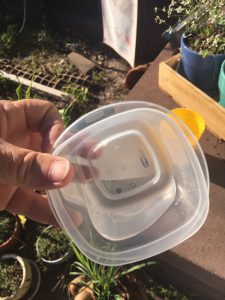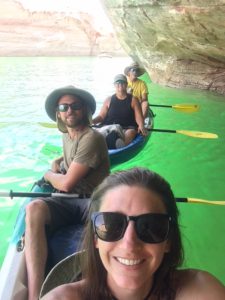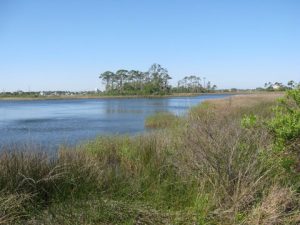In Lesson 1 we learned that the water molecule is polar – it is electrically charged – and attaches itself to other water molecules like a magnet. Because of this polarity it also attaches to other molecules and, many times, can separate (or dissolve) larger compounds. Many of you are experimenting with this right now – if you have the glass jar project going.

Image: Florida Atlantic University
ACTIVITY
– Earlier this week we had a homework assignment. Get at least 3 glass jars, fill 75% with water, in one add an inorganic compound (sand, salt, etc.) – another, an organic compound (leaf, bark, seed, etc.) – and the third, a manmade compound (nail, screw, coin, etc.) and let it sit. The idea is that the “magic molecule” will separate these… eventually 😊
– Let me explain a little further… Compounds are composed of two or more elements combined “electrically”. For example, the sodium molecule has more electrons than it needs and will thus give up one (there is MUCH more to this, but we are not going to get that deep into chemistry). This would make the sodium molecule positive (Na+). The chloride molecule needs more electrons and so takes one from sodium, thus making it negative (Cl–). Opposites attract – so Na+ and Cl– combine to form NaCl – or salt. BUT when water is present – the polar “magic molecule” will disconnect this bond and “dissolve” the salt. Water is called the Universal Solvent because it does this. But it does not dissolve everything.
– That brings us back to our activity… how is it going with these compounds? I am not sure which items you used, but it will be interesting to see if (or when) they begin to dissolve in water. Some may take a LONG time. We will come back to this each week.
In Lesson 2 we look at the fact that “magic molecule” evaporates when it gets warm – becomes vapor in the sky – condenses when it gets cold – and “rains” back to earth. This moves water all over the planet and can be found by living organisms in many different forms – rivers, lakes, ponds, bays, and oceans… even little puddles on your yard. This is the water cycle.

ACTIVITY
In Pensacola, it rained again last night! We really needed it. Take a walk around your yard this morning and see where water collected during the rain. Are any creatures using it? Many times, you will find birds drinking from puddles in the street, there may be mosquito larva in water collected in flowerpots or buckets. Take a look and see today.
For Lesson 3 we are going to discuss how this “rainwater”, as it falls back to Earth, alters the landscape of the planet and provides new habitats for life as well as the water it needs.
Many times, we find rain occurring in the mountains. The Smoky Mountains are called this because of the condensing clouds that hover over them much of the time. As you go higher in the mountains it becomes colder. We now know that this “colder” will trigger condensation of water vapor, the formation of clouds, and the beginning of rain (or snow). As the water falls back on top of the mountains, gravity forces it downhill, forming creeks and streams. As these creeks and streams flow over the land they begin to change the landscape – forming gullies and ditches, making more slopes on the landscape for water to run down and the creeks become larger. Becoming larger they dig deeper gullies and ditches becoming fast flowing rivers where sand is removed, and large rocks are exposed. All of this creates habitat for life and – because of the polarity of the water – adding compounds and molecules to the water itself (we will discuss this in a later lesson).

Eventually these mountain rivers reach the lowlands and they begin to slow their speed and widen into much larger rivers. Rivers in the valley are generally muddy because of all of the sediment and mud they have collected along the way. With the slowing speed and increasing “muddiness” there are new habitats for different creatures. Some of these rivers are still relatively shallow, some become much deeper. Some carve large gashes in the landscape leaving bluffs and hills – some form large canyons and waterfalls. There is none greater than the Grand Canyon – if you have never been there, I highly recommend you put that on your bucket list – well worth the trip – it is amazing.

Eventually these rivers reach the coastal plains, where they slow in speed even more and become even muddier. There still may be some bluffs along the way but more often the landscape flattens, and small beaches of sand deposited by the river form where the rivers meander. Again, this changing landscape will create changing habitats which will support changing life.
And before you know it – the rivers meet the sea. Here the water widens and slows event more. Mobile Bay is 30 miles long and 10 miles wide. It is very muddy. Because of the slow speed and increased compounds in the water, grasses and plants begin to grow along the water’s edge forming marshes, and in some places, grasses even grow BENEATH the water. We no longer call this a river but rather an estuary. All along this trip water has been dissolving and eroding rock and sand. These inorganic compounds are dissolved into the water because of the “magic molecules” polarity, and ability to do this. As the amount of dissolved solids increases, we begin to actually taste and smell this as “salt”. The measure of the amount of dissolved solids (or “salt”) is called salinity (a topic for another lesson) and we begin to notice the change in salinity as we enter the estuary. In addition to the slow movement, grasses on the shoreline and beneath, and the muddy water changing the landscape for life – at least once a day the salty water from the ocean is brought into the estuary by the tides. This too changes the life we can find. Again, we will speak more on all of this in later lessons.

Eventually all water ends up in the ocean, or the Gulf in our case. Here the salinity is as high as it will get, and the amount of water is amazing – 70% of all water on our planet is in the oceans. We know that the bottom of the Gulf has features similar to the ones we find following water from the mountains to the coasts. Bluffs, beaches, canyons, and even more mountains can be found on the bottom. Their shape and distribution are impacted by water just as they are on land.
It is amazing what water has done to shape the way the Earth looks and how life finds places to live. Interestingly, scientists see similar kind of features on other planets – suggesting that water may have once flowed over them as well.

Photo: Molly O’Connor
ACITIVITY
Let’s see how water may have formed your neighborhood.
It did rain in Pensacola last night, and so there may be water running down your street or in your yard.
– Where is it going? How fast is it moving? Are the living creatures using it?
– Is there standing water in your yard? It may be gone by the end of the day – if it did not flow off your property where did it go? Are there any creatures using it?
– Look around your neighborhood… do you find big hills? We have some near my house that we avoid riding our bikes on because we do not want to come back up the hill. It is fun riding down hills, work coming back 😊 These hills were probably formed by water years ago. What is at the bottom of the hill? Usually water. In our case Bayou Texar (an estuary). See where yours goes!
As always be safe outside and have fun.
 0
0
